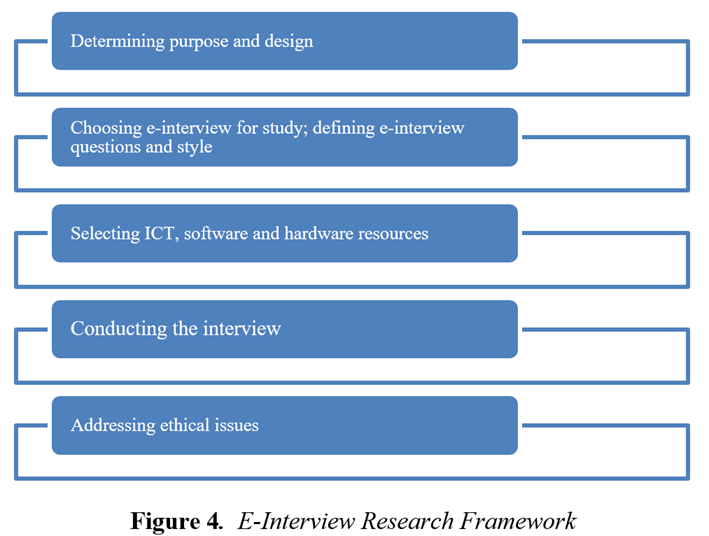Information

In spite of being the most frequently used data collection method of qualitative research, traditional face-to-face interviews are accompanied by certain problems such as geographical distance and restricted physical mobility of participants, as well as financial issues, etc. Over the last few decades, technological changes brought forth by the development of the Internet have led to the development of the online interview in qualitative research, thus overcoming some of the limitations relating to the traditional interview method.
An online interview (also called a digital interview or virtual interview) is an interview conducted remotely using technology and appropriate software platforms. An e-interview research framework is presented in Figure 4:

Both focus group and one-on-one interviews can be conducted in the synchronous mode (real-time) and asynchronous mode (non-real-time). Е-mail, Google questionnaires, online bulletin boards and discussion groups are the most commonly used technologies in asynchronous online interviews. To access the respective software platform, the applicants usually receive a URL link to the meeting, or meeting ID, or a username and password. Applicants must be familiar with the software chosen to conduct an interview. Applicants complete the questionnaire when they have time, and according to their ability. In this case, the focus is on the applicant’s key skills in their natural environment, when they are free of pressure and restrictions.
The synchronous mode is appropriate for applications such as Skype, Zoom, Google Hangouts, Microsoft Teams, video conferencing, and so on. These technologies allow for various options and combinations of one-to-one, one-to-many, and many-to-many communication. The advantages of using these applications are that they provide a free communication service, improve teamwork and interaction among participants, allow for flexible content sharing – without temporal or geographic limitations – and allow for audio or video interviews using a microphone and web camera.
Chat-based recruitment is on the rise because new generations of young people are entering the labor market (Millennials and Generation Z employees). So, employers use tools such as WeChat, WhatsApp and Facebook Messenger to perform pre-screening and early-stage interviews in the hiring process. Vervoe, VidCruiter, SparkHire, interviewstream, Outmatch, AllyO, Mya, and many other platforms offer a set of tools designed to support employers in the hiring process. Despite the abovementioned advantages, it should be noted that the interviewees must be digitally literate, have an access to the high speed Internet, and have some experience in on-line communication in order to take part in such interviews (Janghorban et al., 2014). Moreover, inconsistent Wi-Fi or Internet connections, poor camera/image quality, or sound issues are some of the potential problems that can occur when conducting remote online interviews.
